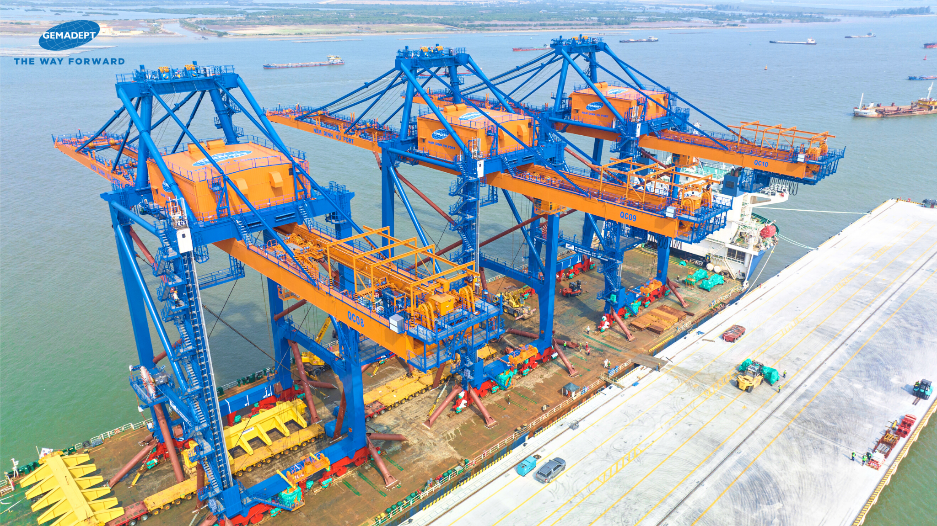


Company’s news
[ {{formatDate('2023-08-03T08:52:14.550Z')}}]

Green port development is the development direction of many businesses, to protect the environment and to increase the competitiveness of businesses themselves.
From Smart Port to Green Port

Newly put into operation in 2021, Gemalink International Port (Cai Mep - Thi Vai port cluster) emerged as one of Vietnam's outstanding seaports when it set a record in the maritime industry and reached the output milestone of 1 million Teu after just one year of operation.
Then just one year after that, by March 2023, the port officially reached 2 million Teu throughput. This is considered the result of investment in construction and operation of the port according to the modern model in which business efficiency is accompanied by environmental protection.
Through the reporter’s research, many equipment at the port are newly invested, with large capacity such as the e-RTG cranes and the STS cranes operating on 100% of grid electricity.
In addition to Gemalink, Nam Dinh Vu port (Hai Phong) has also been following the green port model from the beginning, with 95% of equipment at the port using electric energy.
According to experts, the equipment powered by electricity contributes to turning direct emissions into indirect emissions, reducing the total carbon emissions by more than 50%.
Actual monitoring results on ports using e-RTG cranes show that the use of e-RTG cranes save operating costs by up to 80% compared to RTG cranes using conventional diesel, and reduce carbon emissions released to the environment by up to 80%.
Previously, Saigon Newport in Ho Chi Minh City was the first port in Vietnam to be recognized as a Green port by APEC for meeting the criteria of the Green Port Award System (GPAS) program in 2018.
In 2021, Tan Cang - Cai Mep International Terminal (TCIT) also received the Green Port Award 2020 by the APEC Port Services Network (APSN).
These ports have invested in upgrading equipment, switching from operating using oil to using electricity or clean fuels for cranes and vehicles in the port.
They also found ways to develop solutions to reduce dust in the air and reduce noise, such as using barges to transport goods instead of container trucks.
It can be seen that the smart port model is an option in the transformation of many businesses. The application of information technology also contributes significantly in controlling energy use, optimizing operating productivity, and saving fuel.
From 2022, Quy Nhon port has switched to the E-port model to help customers keep up to date on the status of their vessel and cargo data 24/7. The port also converted two Quay cranes from diesel-powered ones to electric ones to save costs and protect the environment.

Soaring productivity, increasing competitive opportunities
According to Mr. Ho Lien Nam, Deputy General Director of Quy Nhon Port Joint Stock Company, the switch to the E-port model has helped create conveniency for customers. They don’t have to go to the port to do direct procedures like before, saving time and travel costs. The model also contributes to reducing carbon emissions from vehicles.
Since switching to a smart port model, the capacity of Quy Nhon port has increased. Previously, the port took about 5 days to release a 50,000-ton general cargo vessel. But now, since using electrical equipment, it only takes only 2.5 days and the productivity increases by 10-20%. Importantly, operating costs are also significantly reduced.
“The cranes that use DO oil when operating will consume nearly 1 liter of oil, equivalent to 20,000 VND. Still performing the same activity, using an electric crane will only cost about 3,000 VND", Mr. Nam analyzed and said that equipment and supplies using electricity are also less prone to wear and tear. It is also cheaper to repair electric equipment than the ones that use diesel.
Meanwhile, Ms. Nguyen Thi Thu Thao, head of the Public and Investor Relations department (Gemadept Corporation, investor of Gemalink port and Nam Dinh Vu port), said that the development of green ports, the application of advanced technology and software, and the investment in modern equipment have brought many benefits to businesses, creating more value to customers.
According to Ms. Thao, the current highest cargo handling capacity at Gemalink port is 40 containers/crane/hour for cargo containers, 60 containers/crane/hour for empty containers, and 210 containers/vessel/hour.
Meanwhile, Nam Dinh Vu port has an average loading and unloading capacity of 25 - 30 containers/crane/hour at the berth and delivery time in the yard (from the time the customer's vehicle enters the port to the time the operation is completed and the vehicle leaves the port) of only 15 - 20 minutes.
The investment in modern equipment especially helps the ports increase throughput capacity, with actual capacity increasing by at least 20% and saving on paperwork cost. At the same time, it helps increasing competitiveness, meeting the trend of global green standards, and contributing to creating a driving force to promote the process of national digital transformation.
“The major shipping lines in the world are establishing a logistics circle using green and clean energy. Only ports that meet this requirement can participate in the global logistics supply chain," Ms. Thao shared.
Source: https://www.baogiaothong.vn/loi-lon-tu-xanh-hoa-cang-bien-d599133.html